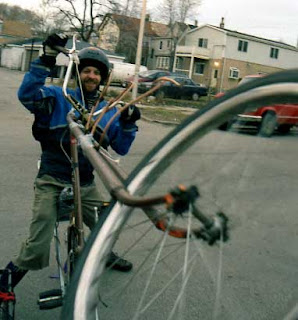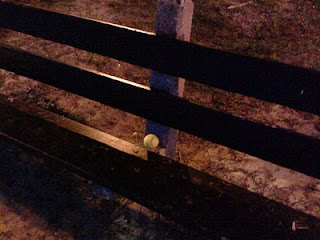Thanks, readers. Followup comments to all things soon to come.
RC: Could you describe a little bit about what Rat Patrol is about?
JP: We're a trash and chopper club. Beyond that each member is welcome to manifest the club in the way they see fit, provided it doesn't reflect negatively on other members (so no cop-fighting or car-window smashing). There's a natural cycle to it- ride through the alleys, find bikes in the trash, weld them up, ride them through the alleys... very self-sustaining. Mostly we like just cruising around, maybe drinking some beers on a railroad trestle. But it can be a powerful influence on your life because you will see people living their dream. We're told all the time that "anything is possible" but you really have to see someone applying that to their life before you figure out how to do it to yours.
RC: on to freak bikes: where do the parts come from? how do people learn to make freak bikes? what does it mean to ride a freak bike?
JP: Some of it is about customizing your own transportation the same way you'd customize your outfit, or put stickers on your laptop, or whatever. But really the key is that these bikes are fun to ride. Riding around
 on something really fun, while people yell encouragement all day, has a tremendous effect on your state of mind. It puts a grin on your face.
on something really fun, while people yell encouragement all day, has a tremendous effect on your state of mind. It puts a grin on your face.The parts come from the alley, or apartment cleanouts, or scrappers. We have open build days where we share the knowledge but you do the work (no handouts here). Most of the time we have an open build at 1048 W. 37th on Sunday between 12 and 6. A few times a year we don't open the shop due to special events but for the most part if you stop by you can make a bike. We have a big pile of frames so all you need is elbow grease, maybe some beer, maybe a few bucks for supplies. Stop by! Note that sometimes Saturday night makes it hard to open promptly at noon Sunday.
RC: how about all this kind of appropriation of freak bikes? I think it was last summer that Brooklyn Industries had a freak bike in their display, and now someone is having freak bike classes in NY. It seems like freak bikes have become (at least) a commercial image. If you agree, what do you think about that? if you don't, tell me that too.
JP: Well, every single counterculture in history has been exploited to some degree. This is what the coolhunting jackals do. But some trends are inherently uncommercializable, such as anticonsumer junk cycling. You can't sell a pre-made, brand new junk bike, it wouldn't be the same. It wouldn't be custom to your body. But then again you can't sell graffiti but there's plenty of merchandizing around that culture.
Fortunately in the bike club world we've seen this happen before and have all been very resistant to co-option. We've had offers from Puma, Coke, MTV, Adidas, etc etc... Vice Magazine came to me and said "you guys are cool we want you in the magazine" and I said "kiss my ass" and so they called us stupid weirdos in the issue... a great reminder of how vipers always smile so big but will bite you in an instant.
In the end I don't have any problem with individuals making money off their passion. Most cor
 porations, though, don't even care what the thing is, they just want the trend. It's just like the media- are they interested in the truth, or do they want a story? If a large corporation really wanted to promote our values they'd do so in a world-improving, nonconsumer way. But of course Coca-cola's not going to do that. But, for example, there was an independent film made about Bike Club last year and the filmmakers have been extremely generous in donating proceeds from ticket, merch, and DVD sales to our African charity. They know they're exploiting a culture and they're trying to atone for it by using the film for good. This is the middle ground between gross corporate exploitation and broke-ass individual self-righteous poverty.
porations, though, don't even care what the thing is, they just want the trend. It's just like the media- are they interested in the truth, or do they want a story? If a large corporation really wanted to promote our values they'd do so in a world-improving, nonconsumer way. But of course Coca-cola's not going to do that. But, for example, there was an independent film made about Bike Club last year and the filmmakers have been extremely generous in donating proceeds from ticket, merch, and DVD sales to our African charity. They know they're exploiting a culture and they're trying to atone for it by using the film for good. This is the middle ground between gross corporate exploitation and broke-ass individual self-righteous poverty.RC: Can you talk about the network of rat patrol groups around the world? What kind of relationships are formed/aided there. If I ride with Rat Patrol in Chicago and then went to hang out with rats elsewhere, what kind of reception would I get? Where would I find them?
In the early days of bike clubs I noticed two other clubs (BLBC [Black Label Bike Club] and Scallywags) rapidly expanding so I granted a chapter to anyone who asked for one. But the hardest thing about having a bike club is having a bike club, so most of them fizz
 led out. Generally it takes an in-person exchange in order to convey our spirit. I'd say you'd find chapters whose culture varies but none of us can take ourselves too seriously, just look at the bikes!
led out. Generally it takes an in-person exchange in order to convey our spirit. I'd say you'd find chapters whose culture varies but none of us can take ourselves too seriously, just look at the bikes!If anybody travels between chapters they're usually well received. Being in a bike club is pretty much an invitation to crash with and party with any other club in the world. How many weirdoes do this worldwide, anyway? 2000? 3000? We simply have to be friends.
We have chapters in Chicago, UK, Lafayette, New Orleans, Ghana, Oz, Tanzania, Nashville, Winnipeg, D.C., Detroit, Ottawa, and Belgium.
RC: on a related note, when I went on a ride, everyone said "once you're on a ride, you're in." What do you think about that?
In the past I've always advocated involuntary press-ganging of anybody who rides with us, ever. In reality it's much more about self-definition. Of course you don't have to be "in" the club if you don't want to, because what does it mean to be in? Each person chooses if they want to wear our colors.
But I've noticed that there's extremely high turnover in the first year, so I always suggest that people spend their first year listening instead of speaking.
To me, personally, you're a prospect until you get that year patch. Lots of people are just looking for something to belong to, so they latch on without examining what we are. Then when we turn out to be- gasp- about riding bikes and digging through the trash (and not, say, an artificial family or an anarchist protest group) they leave. This always happens within the first year. Here's a hint, folks: No matter what your group is, if somebody gets a tattoo of your logo within three months of meeting you, they are looking for identity and not for your club.
RC: How about how rat rides interact with the modern urban setting? Everyone wizzing by one another, no one paying any attention, then they see some weird bikes and fun loving kids being awesome. Could you talk about Rat Patrol peoples' place in cities?
JP: Let's face it- people's lives suck. This culture discourages creativity and uniqueness with an iron fist. Sometimes I actually get angry that riding an unusual bike is considered unusual at all! Each perso
 n *should* be creatively expressing themselves. Instead they labor to cram inside some social structure that leaves them empty and artless. Rat Patrol rips them right out of the rut if only for a moment. It's a little bit of magic in a dull grey world. We give a lot of bikes to kids because that's when they still believe in magic. Kids never question that there's a guy dressed like a monkey on a tallbike, because they are still learning and everything is new. It's amazing how often kids see us when their parents don't- most people will ignore the elephant in the room. This invisibility is what makes us subversive- to the authorities we're this charitable neighborhood dork club, but secretly we are tearing down the very structures that give them authority, by injecting magic into people's lives. It is revolutionary, but not in that "let's win people to our cause by pissing them off" style of most modern activism. Instead we use shared joy and whimsy. Can you see how this all really has nothing to do with bikes?
n *should* be creatively expressing themselves. Instead they labor to cram inside some social structure that leaves them empty and artless. Rat Patrol rips them right out of the rut if only for a moment. It's a little bit of magic in a dull grey world. We give a lot of bikes to kids because that's when they still believe in magic. Kids never question that there's a guy dressed like a monkey on a tallbike, because they are still learning and everything is new. It's amazing how often kids see us when their parents don't- most people will ignore the elephant in the room. This invisibility is what makes us subversive- to the authorities we're this charitable neighborhood dork club, but secretly we are tearing down the very structures that give them authority, by injecting magic into people's lives. It is revolutionary, but not in that "let's win people to our cause by pissing them off" style of most modern activism. Instead we use shared joy and whimsy. Can you see how this all really has nothing to do with bikes?


